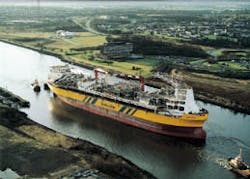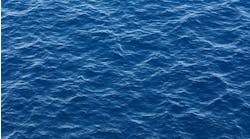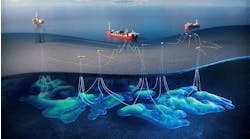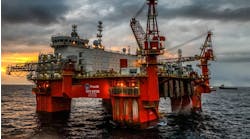Jeremy Beckman
London
Bluewater's FPSO Belo Holm, headed to the Ross Field for production duty.
Void looming for Norwegian yards
Norway's development prospects are looking lean. Statoil's Kvitebjoern is the latest of a string of projects to be suspended. Like so many others in the North Sea, it was rendered unprofitable by current oil prices.The one blip on the downward curve is Statoil's Huldra, the PDO for which was waived through by the Storting Parliament in February. Aker Verdal is building the jacket and piles, while Kvaerner Rosenberg is delivering the 3,500-ton wellhead platform.
Only a year ago, brimful Norwegian yards were virtually turning away new orders. But at a recent full-year results presentation, Kvaerner's CEO Kjell Almskog warned of impending scaling down of the company's oil and gas activities. Subsea design is the untouchable exception. Kvaerner's difficulties have been compounded by cost overruns of up to $50 million and $25 million incurred respectively on the ?sgard and Jotun floaters, Almskog claimed. Late design changes imposed by the clients were a major contributor.
Statoil's own results statement for 1998 gave little respite. This included a provision of NKr 1.5 billion for losses on rig contracts and also write-downs pertaining to the Varg and Yme fields. No significant oil reserves were discovered by Statoil off Norway last year, and it sees little prospect of improving its yield in the sector without internal structural change or modifications to the government's oil industry policy.
Saga, one of the North Sea's leading independents, turned in a loss of over NKr 1.5 billion, compared with a surplus of over NKr 3 billion the previous year. For the time being, said CEO Diderik Schnittler, group outlay will have to be heavily streamlined, and that includes deepwater exploration off Mid-Norway. One Saga-operated well in 1,400 meters of water on the Gjallar prospect will go ahead, to gauge potential for developing big fields in this zone. But even a positive well result would be put on ice, Schnittler said, until the market came up with technology for a lower cost development.
Schnittler did not see production from newer Norwegian projects being halted, despite the price slump, as their built-in OPEX was relatively low. But the government needed to re-ignite the sector in some way, he warned, possibly by rescinding Norway's onerous carbon dioxide taxes. Continued state inaction looks unlikely, given the reliance of Norway's economy on petroleum.
Lasmo is another beleaguered mid-size independent looking beyond its traditional base, the North Sea, for profits. Chief executive Chris Wright, discussing the company's operating loss, called for extra royalty relief in the UK sector, "otherwise frontier areas of the UK will not see exploration wells". Lasmo has commitment wells west of Shetland this year, including one on BP's Brackie prospect, but there is no certainty that they will be drilled in the current climate, he added.
Phillips maintains J-block strike rate
Away from the Shetlands, most exploration drilling off the UK of late has been targeting reserves within reach of production platforms. Phillips' latest campaign in Central North Sea blocks 30/7a and b culminated in an oil and gas discovery four and a half miles from its Judy platform. The well, spudded in November by the Santa Fe 135, tested 4,000 b/d and 42 MMcf/d at 6,080 psi flowing tubing pressure through a 40/64-in. choke. It joins a backlog of J-block area finds which Phillips is striving to coordinate as a new development.In UK blocks 15/27 and 15/28b, Phillips' R-block oilfields Renee and Rubie have just come onstream, prolonging the life-span of their host production semi in block 15/21, Amerada Hess' AH-001. The 13-km subsea tieback will eventually triple production at the floater to 41,000 b/d, offsetting the decline from its dedicated Ivanhoe, Rob Roy, and Hamish fields.
Also in the central sector, Talisman Energy's Ross Field should finally be outputting first oil following protracted fit-out delays to the Bleo Holm FPSO. Talisman also clinched UK government approval to tie back Orion (a 1971 discovery) 16 km to its Clyde platform.
The company is aiming for first oil and gas late this year.
German gas opens pipeline extension
Germany's first offshore gas development is underway following a sales agreement between Gasunie and the Deutsches Nordseekonsortium (led by Wintershall). The project is also significant in that it opens an extension northwards of the Dutch North Sea trunkline system, which could in turn spur further exploration and development in the northern Dutch sector.The A6/B4 Field, which lies 300 km off the German coast, will be exploited via a six-pile steel platform in 48 meters water depth, with two to three production wells generating around 3.3 MMcm/d of gas for up to 16 years (depending on economic conditions). Newly installed gas and condensate pipelines will carry production 117 km south to the F3 platform, from where the gas will feed into the NOGAT trunkline to the Dutch mainland.
In the Norwegian sector, Statoil claims to have saved NKr 230 million by shortening the planned Gullfaks A to Gullfaks C gas export line from 85 km to 32 km. The revised plan involves installing a loop between the two Gullfaks platforms which would tie into the Statpipe system via a hot-tap operation.
Wholescale concrete dumping not inevitable
Redundant concrete platforms could be safely re-floated, according to a report in the Quarterly Review of the North Sea abandonment market. A recent study in Norway contradicts the accepted Ospar line that these structures may be safer left on the seabed.The study, performed on behalf of Shell, Statoil, the Norwegian Petroleum Directorate, and Aker Maritime, reviewed the Gullfaks C Condeep design, considered representative of most concrete platforms in the North Sea. Lead consultants Olav Olsen concluded that the key to a re-float would be the moment the platform was detached from the seabed. At this point, deballasting of the shafts would have to dovetail with the pressure applied beneath the skirt piles.
Fine-tuning this procedure would lead to a controlled release, which could even be interrupted, if required. Similar conclusions have been reached on studies into the Ekofisk Tank and theDraugen platform.
Copyright 1999 Oil & Gas Journal. All Rights Reserved.




